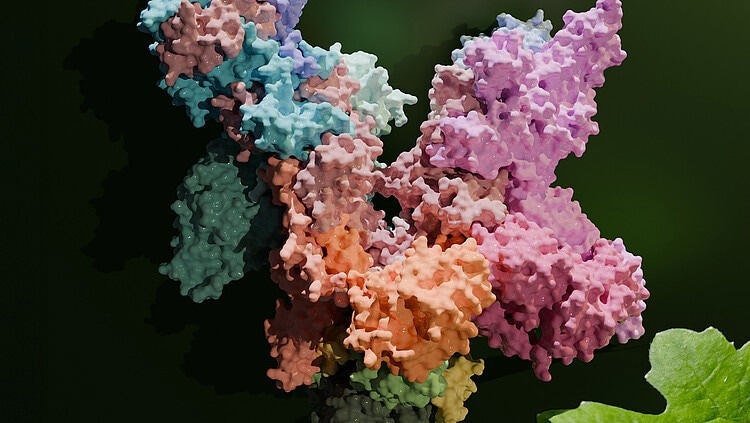Plants have to carry out photosynthesis and ultimately synthesize oxygen and chemical energy with the assistance of sunlight to support life on Earth. For the first time, researchers in Göttingen and Hannover have successfully seen the chloroplast copying machine, the RNA polymerase PEP, in high-resolution 3D.
 The image shows a high-resolution 3D model of the plant RNA polymerase PEP, which plays a central role in photosynthesis. Image Credit: Paula Favoretti Vital do Prado and Johannes Pauly / MPI-NAT, UMG
The image shows a high-resolution 3D model of the plant RNA polymerase PEP, which plays a central role in photosynthesis. Image Credit: Paula Favoretti Vital do Prado and Johannes Pauly / MPI-NAT, UMG
The precise structure sheds fresh light on the function and development of this intricate biological mechanism, which is crucial in interpreting the genetic instructions for photosynthesis proteins.
All life on Earth depends on photosynthesis; without it, there would be no air to breathe. Plants are able to use light energy from the sun to transform carbon dioxide and water into chemical energy and oxygen through this intricate mechanism. In the chloroplasts, the central component of photosynthesis, the conversion occurs.
Over the course of evolution, a photosynthetic cyanobacterium was absorbed by the progenitors of modern plant cells, leading to the development of chloroplasts. Although the bacterium lost some important functions over time, like photosynthesis and some portions of the bacterial genome, it became more and more reliant on its “host cell.”
As a result, the chloroplast still possesses its own DNA, which is the source code for essential proteins that comprise the “photosynthesis machinery.”
With PEP to Energy
A unique molecular copying machine, an RNA polymerase called PEP, reads the genetic instructions from the chloroplasts’ genetic material.”
Dr. Hauke Hillen, Professor, University Medical Center
Hillen is also research group leader at the Max Planck Institute (MPI) for Multidisciplinary Sciences and also a member of the Göttingen Cluster of Excellence “Multiscale Bioimaging” (MBExC).
It is essential for activating the genes required for photosynthesis, Hillen emphasises. Without a functioning PEP, plants cannot photosynthesise and remain white instead of turning green.
The copying machine itself is complicated, in addition to the copying process: It is composed of a minimum of twelve associated proteins, or PAPs, and a multi-subunit core complex, the protein components of which are encoded in the chloroplast genome. The instructions for these are contained in the nuclear genome of the plant cell.
So far, we have been able to characterise some individual parts of the chloroplast copying machine structurally and biochemically, but we lacked a precise insight into its overall structure and the functions of the individual PAPs.”
Dr Thomas Pfannschmidt, Professor, Institute of Botany, Leibniz University Hannover
Detailed Snapshot in 3D
Working closely together, Hauke Hillen and Thomas Pfannschmidt’s team of researchers has now successfully visualized a 19-subunit PEP complex in three dimensions for the first time, with a resolution of 3.5 angstroms , or 35 million times smaller than a mm.
We isolated intact PEPs from white mustard, a typical model plant in plant research.”
Frederik Ahrens, Study First Author and Research Assistant, Institute of Botany, Leibniz University Hannover
The study was published in the journal Molecular Cell.
The researchers then produced a comprehensive three-dimensional model of the 19-part PEP complex using cryo-electron microscopy. The samples were ultra-fast flash-frozen for that purpose. Subsequently, the researchers took thousands of photos of the copying machine—even down to the atomic level—from various angles, and then used intricate computer calculations to combine them into a single overall image.
Paula Favoretti Vital do Prado, Study First Author and a Ph.D. student at MPI, and a member of the MBExC’s Hertha Sponer College, added, “The structural snapshot showed that the PEP core is similar to those in other RNA polymerases, such as in bacteria or the cell nucleus of higher cells. However, it contains chloroplast-specific features that mediate the interactions with the PAPs. The latter we find only in plants and they are unique in their structure.”
Scientists previously believed that PAPs read the genes involved in photosynthesis to fulfill specific roles.
Hillen added, “As we could show, the proteins arrange themselves in a special way around the RNA polymerase core. Based on their structure, it is likely that the PAPs interact with the core complex in various ways and are involved in the gene reading process.”
Understanding the Evolution of Photosynthesis
The research team also looked for evolutionary hints in databases. They aimed to determine whether other plants share the copying machine’s architecture.
Pfannschmidt stated, “Our results indicate that the structure of the PEP complex is the same in all land plants.”
The recent discoveries regarding the process of chloroplast DNA replication contribute to the understanding of the basic mechanisms underlying the biogenesis of the photosynthesis machinery. They can be useful in the future for biotechnological applications as well.
Source:
Journal reference:
do Prado, P. F. V., et al, (2024) Structure of the multi-subunit chloroplast RNA polymerase. Molecular Cell. doi.org/10.1016/j.molcel.2024.02.003